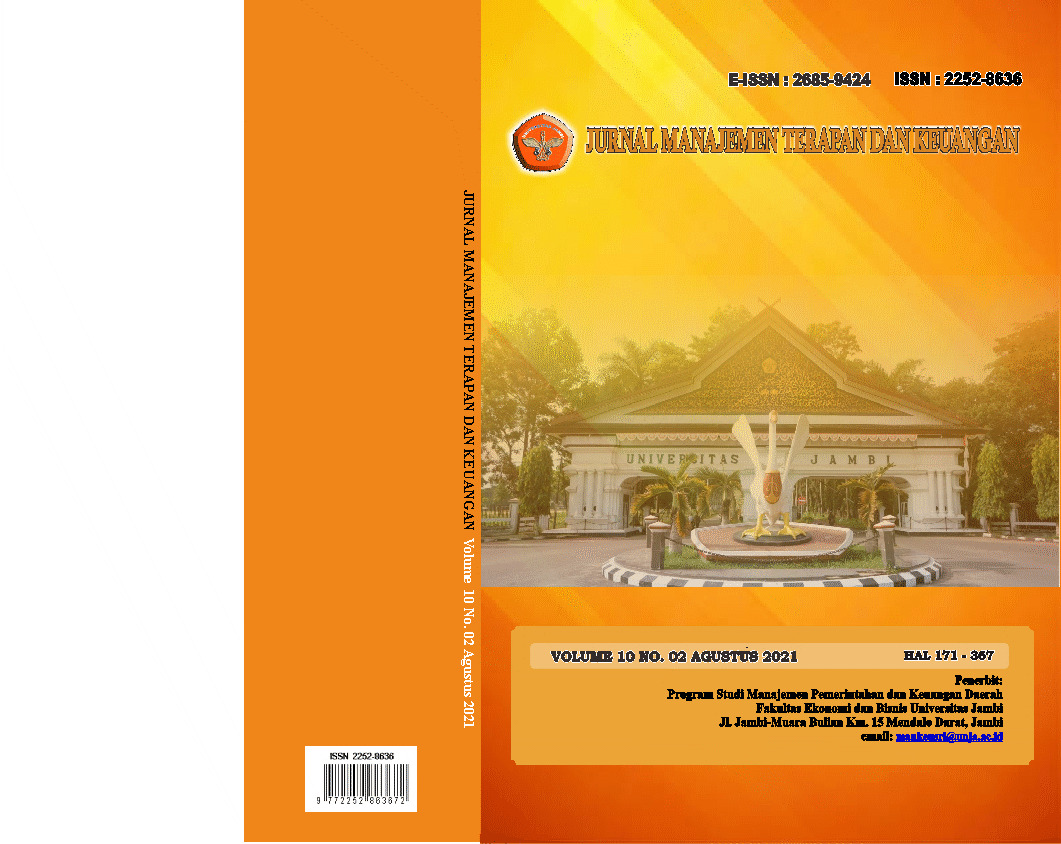TELECOMMUTING: STRATEGI MENINGKATKAN KEPUASAN KERJA KARYAWAN DENGAN PENDEKATAN DISPOSISIONAL, MODEL KEPUASAN KERJA, DAN MODEL KARAKTERISTIK PEKERJAAN
DOI:
https://doi.org/10.22437/jmk.v12i04.28347Abstract
Telecommuting telah menjadi mode kerja yang semakin populer menjadi fenomena yang berkembang di dunia yang lebih maju selama dua dekade terakhir. Telecommuting memungkinkan karyawan untuk melakukan semua atau sebagian dari pekerjaan mereka dari rumah, menggunakan teknologi telecommuting canggih dan peralatan internet untuk mengirim dan menerima pekerjaan secara elektronik dari rumah ke kantor, dan sebaliknya sehingga telecommuting memungkinkan orang untuk menyeimbangkan pekerjaan dan kehidupan keluarga mereka. Pengaturan telecommuting membawa ke garis depan gagasan bahwa pekerjaan bukan lagi bicara tempat, tetapi apa yang dilakukan, dan cara-cara kerja baru kemungkinan akan terus berlanjut. Pemahaman multidisiplin dan komprehensif tentang manfaat dan kelemahan telecommuting dapat digunakan untuk membentuk dan menginformasikan praktik organisasi dan kebijakan publik secara lebih efektif.
Downloads
References
Ansong, E., & Boateng, R. 2017. Organisational adoption of telecommuting: Evidence from a developing country. EJ Info Sys Dev Countries 84:e12008. https://doi.org/10.1002/isd2.12008. wileyonlinelibrary.com/journal/isd2.
Allen, T. D., Golden, T. D., & Shockley K. M. 2015. How Effective Is Telecommuting? Assessing the Status of Our Scientific Findings. Psychological Science in the Public Interest 2015, Vol. 16(2) 40 –68. DOI: 10.1177/1529100615593273 pspi.sagepub.com.
Baker, E., Avery, G. C., & Crawford, J. Baker, E., Avery, G. C. & Crawford, J. 2007. Satisfaction and Perceived Productivity when Professionals Work From Home. Research and Practice in Human Resource Management, 15(1), 37-62.
Bailey, D. E., & Kurland, N. B. 2002. A review of telework research: findings, new directions, and lessons for the study of modern work. Journal of Organizational Behavior: 23, 383–400.
DuBrin, A. J. 1991. Comparison of the Job Satisfaction and Productivity of Telecommuters Versus In-House Employees: A Research Note On Work In Progress. Psychological Reports, 1991, 68, 1223-1234.
Fay. M. J., & Kline, S. L. 2011. Coworker Relationships and Informal Communication in High-Intensity Telecommuting, Journal of Applied Communication Research, 39:2, 144-163.
Fonner, K. L., & Roloff, M. E. 2010. Why Teleworkers are More Satisfied with Their Jobs than are Office-Based Workers: When Less Contact is Beneficial. Journal of Applied Communication Research: Vol. 38, No. 4, November 2010, pp. 336_361.
Gajendran R. S., & Harrison, D. A. 2007. The Good, the Bad, and the Unknown About Telecommuting: MetaAnalysis of Psychological Mediators and Individual Consequences. Journal of Applied Psychology, Vol. 92, No. 6, 1524–1541.
Gajendran, T., Brewer, G., Gudergan, S. & Sankaran, S. 2014. Deconstructing dynamic capabilities: the role of cognitive and organizational routines in the innovation process, Construction Management and Economics, 32:3, 246-261.
Golden T. D. 2006. The role of relationships in understanding telecommuter satisfaction. Journal of Organizational: 27, 319–340.
Golden, T. D., & Veiga J. F. 2005. The Impact of Extent of Telecommuting on Job Satisfaction: Resolving Inconsistent Findings. Journal of Management, Vol. 31 No. 2, April 2005 301-318 DOI: 10.1177/0149206304271768.
Golden, T. D., Veiga, J. F., & Dino, R. N. 2008. The Impact of Professional Isolation on Teleworker Job Performance and Turnover Intentions: Does Time Spent Teleworking, Interacting Face-to-Face, or Having Access to Communication-Enhancing Technology Matter? Journal of Applied Psychology, Vol. 93, No. 6, 1412–1421.
Hackman, J. R., & Oldham, G. R. 1976. Motivation through the design of work: Test of a theory. Organizational Behavior and Human Performance, 16: 250-279.
Hartman, R. I., Stoner, C. R., & Arora, R. 1991. An Investigation of Selected Variables Affecting Telecommuting Productivity and Satisfaction. Journal of Business and Psychology: Volume 6, No. 2, Winter 1991.
Johnson, L. S. 2016. Predictors of Job Satisfaction Among Telecommuters. Walden Dissertations and Doctoral Studies Collection. ScholarWorks. Walden University.
Kelly, G. G., & Locke, K. 1999. The Telecommuting Life: Managing Issues of Work, Home and Technology. USA: Idea Group Publishing.
Kinicki, A. & Fugate, M. 2018. Organizational Behavior: A Practical, Problem-Solving Approach. New York: McGrawHill.
Kinicki, A. J., Schriesheim, C. A., McKee-Ryan, F. M., & Carson, K. P. 2002. Assessing the Construct Validity of the Job Descriptive Index: A Review and Meta-Analysis. Journal of Applied Psychology, Vol. 87, No. 1, 14–32.
Mokhtarian, P. L., Balepur, P. N., & Varma, K. V. 1998. Transportation impacts of center-based telecommuting: Interim findings from the Neighborhood Telecenters Project. Transportation 25: 287–306, 1998.
Noonan, M. C., & Glass J. L. 2012. The hard truth about telecommuting. Monthly Labor Review: June, 38-45.
Olson, M. H., & Primps, S. B. 1984. Working at Home with Computers: Work and Nonwork Issues. Journal of Social Issues, Vol. 40, No. 3, 1984, pp. 97-112.
O’Neill, T. A., Hambley, L. A., Greidanus, N. S., MacDonnell, R., & Kline, T. J. B. 2009. Predicting teleworker success: an exploration of personality, motivational, situational, and job characteristics. New Technology, Work and Employment 24:2.
Pinder, C. C. 2008. Work Motivation in Organizational Behavior. Upper Saddle River, NJ: Prentice Hall.
Robbins, S. P., & Judge, T. A. 2018. Essentials of Organizational Behavior. England: Pearson.
Smith, S. A., Patmos A., & Pitts, M. J. 2018. Communication and Teleworking: A Study of Communication Channel Satisfaction, Personality, and Job Satisfaction for Teleworking Employees. International Journal of Business Communication 2018, Vol. 55(1) 44 –68.
Sullivan, Cath., & Lewis, S. 2001. Home-Based Telework, Gender and the Synchcronization of Work and Family: Perspectives of Teleworkers and Their Co-Residents. Gender, Work and Organization, Vol. 8, No. 2, 123-145.
Turetken, O., Jain, A., Quesenberry, B., & Ngwenyama, O. 2011. An Empirical Investigation of the Impact of Individual and Work Characteristics on Telecommuting Success. IEEE Transactions on Professional Communication, Vol. 54, No. 1.
Vega, G. 2003. Managing Teleworkers and Telecommuting Strategies. London: Praeger.
Virick, M., DaSilva, N., Arrington, K. 2010. Moderators of the curvilinear relation between extent of telecommuting and job and life satisfaction: The role of performance outcome orientation and worker type. Human Relations 63(1) 137–154.
Weiss, H. M., & Cropanzano, R. (1996). Affective events theory: A theoretical discussion of the structure, causes, and consequences of affective experiences at work. Research in Organizational Behavior, Vol. 18: 1-74. JAI Press Inc.
Downloads
Published
How to Cite
Issue
Section
License
Copyright (c) 2023 Nur Hasanah

This work is licensed under a Creative Commons Attribution 4.0 International License.









